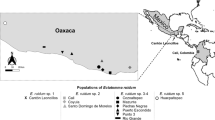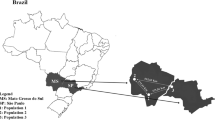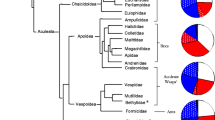Abstract
Cuticular hydrocarbons have been identified as the source of sex-recognition signals for many insects, but for social insects, specifically ants, cuticular hydrocarbon profiles of males are often ignored. This study reports male-specific cuticular hydrocarbon patterns for the trap-jaw ant Odontomachus brunneus. Analysis of samples from four Florida populations demonstrated that male-specific overabundance of four hydrocarbons is conserved across populations despite population-level divergence of the remainder of the profile. In addition, hydrocarbon patterns unique to adult males were not present on the cuticle of final instar male larvae, indicating that male-specific profiles arise late in development. The pattern of an abundant subset of conserved cuticular hydrocarbons characteristic of males across divergent populations was compared to earlier findings of the conservation of fertility signals of females across these same populations.


Similar content being viewed by others
References
Antonialli WF, Lima SM, Andrade LHC, Suarez YR (2007) Comparative study of the cuticular hydrocarbons in queens, workers and males of Ectatomma vizottoi (Hymenoptera, Formicidae) by Fourier transform-infrared photoacoustic spectroscopy. Genet Mol Res 6:492–499
Beibl J, D’Ettorre P, Heinze J (2007) Cuticular profiles and mating preference in a slave-making ant. Insect Soc 54:174–182
Buser HR, Arn H, Guerin P, Rauscher S (1983) Determination of double bond position in mono-unsaturated acetates by mass spectrometry of dimethyl disulfide adducts. Anal Chem 55:818–822
Chernenko A, Holman L, Helantera H, Sundstrom L (2012) Cuticular chemistry of males and females in the ant Formica fusca. J Chem Ecol 38:1474–1482
Cremer S, Sledge MF, Heinze J (2002) Chemical mimicry—male ants disguised by the queen’s bouquet. Nature 419:897
Cremer S, D’Ettorre P, Drijfhout FP, Sledge MF, Turillazzi S, Heinze J (2008) Imperfect chemical female mimicry in males of the ant Cardiocondyla obscurior. Naturwissenschaften 95:1101–1105
Cuvillier-Hot V, Cobb M, Malosse C, Peeters C (2001) Sex, age and ovarian activity affect cuticular hydrocarbons in Diacamma ceylonense, a queenless ant. J Insect Physiol 47:485–493
Deyrup M, Cover S (2004) A new species of Odontomachus ant (Hymenoptera : Formicidae) from inland ridges of Florida, with a key to Odontomachus of the United States. Fla Entomol 87:136–144
Endler A, Liebig J, Schmitt T, Parker JE, Jones GR, Schreier P, Hölldobler B (2004) Surface hydrocarbons of queen eggs regulate worker reproduction in a social insect. Proc Natl Acad Sci USA 101:2945–2950
Endler A, Liebig J, Hölldobler B (2006) Queen fertility, egg marking and colony size in the ant Camponotus floridanus. Behav Ecol Sociobiol 59:490–499
Ferveur JF, Cobb M (2010) Behavioral and evolutionary roles of cuticular hydrocarbons in Diptera. In: Blomquist GJ, Bagnères AG (eds) Insect hydrocarbons: biology, biochemistry, and chemical ecology. Cambridge University Press, Cambridge, pp 325–343
Ginzel MD (2010) Hydrocarbons as contact pheromones of longhorned beetles (Coleoptera: Cerambycidae). In: Blomquist GJ, Bagnères AG (eds) Insect hydrocarbons: biology, biochemistry, and chemical ecology. Cambridge University Press, Cambridge, pp 375–389
Greene MJ (2010) Cuticular hydrocarbon cues in the formation and maintenance of insect social groups. In: Blomquist GJ, Bagnères AG (eds) Insect hydrocarbons: biology, biochemistry, and chemical ecology. Cambridge University Press, Cambridge, pp 244–253
Hojo MK, Wada-Katsumata A, Akino T, Yamaguchi S, Ozaki M, Yamaoka R (2009) Chemical disguise as particular caste of host ants in the ant inquiline parasite Niphanda fusca (Lepidoptera: Lycaenidae). Proc Roy Soc B 276:551–558
Holman L, Lanfear R, D’ Ettorre P (2013) The evolution of queen pheromones in the ant genus Lasius. J Evol Biol 26:1549–1558
Johnson CA, Sundstrom L (2012) Cuticular chemistry of two social forms in a facultatively polygyne ant (Hymenoptera: formicidae: Formica truncorum). Ann Zool Fenn 49:1–17
Lacaille F, Hiroi M, Twele R, Inoshita T, Umemoto D, Maniere G, Marion-Poll F, Ozaki M, Francke W, Cobb M, Everaerts C, Tanimura T, Ferveur JF (2007) An inhibitory sex pheromone tastes bitter for Drosophila males. PLoS ONE 2:e661
Liebig J (2010) Hydrocarbon profiles indicate fertility and dominance status in ant, bee, and wasp colonies. In: Blomquist GJ, Bagnères AG (eds) Insect hydrocarbons: biology, biochemistry, and chemical ecology. Cambridge University Press, Cambridge, pp 254–281
Martin S, Drijfhout F (2009) A review of ant cuticular hydrocarbons. J Chem Ecol 35:1151–1161
Olaniran OA, Sudhakar AVS, Drijfhout FP, Dublon IAN, Hall DR, Hamilton JGC, Kirk DJK (2013) A male-predominant cuticular hydrocarbon, 7-methyltricosane, is used as a contact pheromone in the western flower thrips Frankliniella occidentalis. J Chem Ecol 39:559–568
Ratnieks FLW, Foster KR, Wenseleers T (2006) Conflict resolution in insect societies. Annu Rev Entomol 51:581–608
Siegel S, Castellan NJ (1988) Nonparametric statistics for the behavioral sciences, 2nd edn. McGraw-Hill, New York
Smith AA, Millar JG, Hanks LM, Suarez AV (2012) Experimental evidence that workers recognize reproductives through cuticular hydrocarbons in the ant Odontomachus brunneus. Behav Ecol Sociobiol 66:1267–1276
Smith AA, Millar JG, Hanks LM, Suarez AV (2013) A conserved fertility signal despite population variation in the cuticular chemical profile of the trap-jaw ant Odontomachus brunneus. J Exp Biol 216:3917–3924
Tregenza T, Wedell N (1997) Definitive evidence for cuticular pheromones in a cricket. Anim Behav 54:979–984
van Zweden JS, d’Ettorre P (2010) Nestmate recognition in social insects and the role of hydrocarbons. In: Blomquist GJ, Bagnères AG (eds) Insect hydrocarbons: biology, biochemistry, and chemical ecology. Cambridge University Press, Cambridge, pp 222–243
Acknowledgments
We thank Walter R. Tschinkel, Joshua R. King, Bill Wills, and Fred Larabee for collection assistance. The Archbold Biological Station, the Pine Jog Environmental Education Center, and Seminole County provided access and permission to collect at our field sites. We thank two anonymous reviewers for their helpful comments.
Author information
Authors and Affiliations
Corresponding author
Additional information
Handling Editor Kerstin Reifenrath.
Electronic supplementary material
Below is the link to the electronic supplementary material.
Rights and permissions
About this article
Cite this article
Smith, A.A., Vanderpool, W., Millar, J.G. et al. Conserved male-specific cuticular hydrocarbon patterns in the trap-jaw ant Odontomachus brunneus . Chemoecology 24, 29–34 (2014). https://doi.org/10.1007/s00049-013-0143-0
Received:
Accepted:
Published:
Issue Date:
DOI: https://doi.org/10.1007/s00049-013-0143-0




